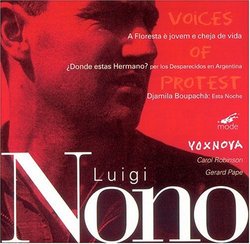| All Artists: Luigi Nono, Nova, Robinson, Pape Title: Vocal Works Members Wishing: 1 Total Copies: 0 Label: Mode Release Date: 5/23/2000 Genres: Pop, Classical Styles: Vocal Pop, Opera & Classical Vocal Number of Discs: 1 SwapaCD Credits: 1 UPC: 764593008729 |
Search - Luigi Nono, Nova, Robinson :: Vocal Works
 | Luigi Nono, Nova, Robinson Vocal Works Genres: Pop, Classical |
Larger Image |
CD Details |
CD ReviewsCutting edge 1960s radicalism R. Hutchinson | a world ruled by fossil fuels and fossil minds | 07/07/2002 (5 out of 5 stars) "This outstanding new recording on Mode Records features one of Nono's masterworks, "A floresta e jovem e cheja de vida" (The Forest Is Young and Full of Life), from 1965/6. It was dedicated to the National Front for the Liberation of Vietnam. Listening to this stark and horrific piece, one is reminded of how radical the 1960s were, and how in many respects everything since then has been retrenchment. Vox Nova executes the vocal component in amazing fashion, while the use of tapes is mixed by Gerard Pape. There was no exact score for this piece, which was recorded only once, and so Pape and the performers had to participate in the composition process anew, as Nono would wish. Some who have heard the original claim that this new version is far more powerful! Also included are two shorter vocal works. Mode calls this recording "Luigi Nono, Volume 1," and so we have more music by one of the 20th century's greatest composers to look forward to..." Impassioned political canti to struggles in the 20th century scarecrow | Chicago, Illinois United States | 12/28/2001 (5 out of 5 stars) "This is the only work I know within the classical serious realm dedicated to the disappeared.(Well Christian Wolff has a piano solo). Nono here refers to the disappeared in Central and South America,for which there are numerous, and no one generation has it been limited to.But he specifically indicates Argentina, from the Mothers of the Plaza de Mayo, who came every Thursday to hold up photos of those lost,murdered,gone in Argentina.This is a threadbare work, with open timbres for four women voices, 2 Sopranos, mezzo soprano and contralto.When you first hear this work,it sounds like elctronic music.Here amply effective use of silences,typically of late Nono. In anyone else's creative hands unaccompanied voices might be an invitation to mistreated timbres, but Nono has always preferred the power and humanistic, direct timbre of the voice. It is applicably tortured in the highest regions for the pencil thin voices, and simply states the words of the title,"Donde Estas Hermano?" stretched over the length of the modest, gut wrenching work.It is also deeply beautiful in momnets, with solos occuring amongst the voices, like solo declamations,on the atrocities the work reflects.
Nono's aesthetic had favored the challenges of vocal music, he naturally found it as a useful metaphor for the wide spectrum of political subject matter throughout the 20th Century. The " A Floresta E Jovem E Cheia de vida" is from 1966, a particular work from the imagery of Vietnam,'bring new life from the forest',or "the forest is full of life". This is for,soprano, three reciters, Bb Clarinet, copper plates, and 8 channel tape, texts assembled by Giovanni Pirelli.There is wonderful multiphoni focused section here played by William O. Smith,who,(it is often forgotten) had pioneered this use in the early Sixties. The work is dedicated to the National Front for the Liberation of Vietnam, and is a seminal like oratorio, with shouting, expressionistic screams, declamatory statements, deeply dramatic,with high tension microintervals,very transparent moments,high register only. I can very easily see this work staged. The Left in Europe for which Nono was a part saw the Vietnam War as an important struggle against the imperial designs of the USA. This represented the end of the first creative period with now the utilization of electronic means. Nono had considered electronics the use of extramusical materials as equivalent to film, and commentary. Aside from it's own independent revolutionary techinical possibilities, which in itself was an alternative genre to the concert hall.'Canti d Vita e D'Amore' was a powerfully overwrought work, deeply impressive to todays date actually, with its utilization of palindromic divisi string writing in clusters, very close on the heel of Penderecki's "Threnody to the Victims of Hiroshima". However Nono broadened and expanded the concept to a full scale oratorio like work for multiple voices and large orchestra. Here the excerpt is from an Algerian women, Djamila Boupacha who was hideously tortured by the French in the resistance against the Occupation of the French in the early Sixties,including acts of terrorism. This led to a string of events culminating in the independence of Algeria, but not till ultimate repression against Algerians in France, where they were wantonly murdered had occurred. Here Nono utilizes the impassioned focus of the solo soprano voice,in a pointillistic deeply disturbing use of the voice, screeches to high C, with deeply wrought exposed tortured atonal lines, unaccompanied.The text from a Spanish revolutionary,Jesus Lopez Pacheco tells of the darkness of the night,the poem"This night" of the voice which reaches no ones ear. The singing here also uses the closed mouth as like a muffled muting of the vocal timbre." |
